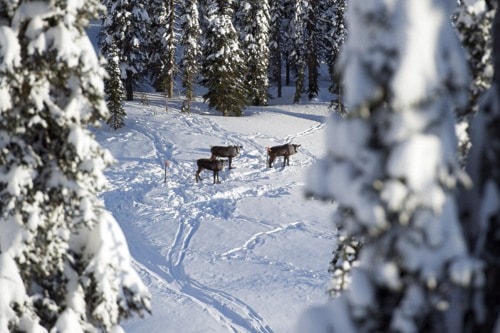“The North Thompson/Wells Gray herd remains threatened, as do mountain caribou throughout their range,” says Brennan Clarke, spokesperson for the Ministry of Forests, Lands and Natural Resource Operations.
Clarke was responding to questions raised in a letter to the editor from Yellowhead Ecological Association that ran in our Feb. 27 issue. The letter, under the head “Caribou population threatened with decline,” charged that regulations put in place to protect mountain caribou in B.C. were inadequate and not being enforced.
“This government is committed to rebuilding mountain caribou numbers to pre-1995 levels of more than 2,500 animals by 2027. The current estimate is around 1,700 individuals,” Clarke said.
“We are addressing this issue with the Mountain Caribou Recovery Implementation Plan, a long term strategy that supports the recovery of this herd and many others.”
Part of the strategy has involved setting up Ungulate Winter Ranges (UWRs). These are areas where ungulates (deer, moose, elk, caribou, sheep, goats) spend the winter months. These areas are chosen based on the advice of professional biologists who assess the desired habitat conditions for each species.
The province has protected 2.2 million hectares of high-suitability mountain caribou habitat. Road-building and logging are now prohibited in these areas.
In February 2010 the province signed 12 stewardship management agreements (SMAs) with individual snowmobile clubs.
“Because of the SMAs’ proximity to nearby caribou habitat, the clubs are required to stay out of nearby closed areas, report the amount of snowmobile use and record any encounters with caribou. These requirements are reviewed annually to ensure compliance,” Clarke said.
More than one million hectares of historic caribou habitat remains closed to recreational snowmobile use, said the ministry spokesperson.
Clarke did not accept a charge in the letter that Worksafe BC regulations regarding avalanche safety was keeping conservation officers and others from enforcing regulations in the backcountry.
“No, there is no deficiency in monitoring and enforcement due to WorkSafe BC avalanche safety regulations,” he said. “Monitoring and enforcement of restricted caribou habitat and SMAs is done almost entirely by aerial surveillance and is not affected by the new regulations. Conservation officers also patrol parking lots and staging areas near these restricted areas.”
Clarke also pointed out that 21 per cent of current mountain caribou herd areas are within provincial or federal parks.
An additional 48 per cent of current mountain caribou herd areas are being managed for mountain caribou recovery and maintenance, which may include partial or no forest harvesting areas as well as maintaining habitat to allow animals to move between herd areas.
Approximately 95 per cent of the core winter range is being managed to protect habitat.
Government has suspended the issuance of new commercial recreation tenures over 23 per cent of existing mountain caribou herd areas.
The spokesperson noted that the caribou recovery strategy also includes the recent transfer of 19 radio-collared animals from a donor herd near Dease Lake to the threatened Purcells-South herd in the Kootenay region.
